Rose cut diamond faceting creates distinctive flat-bottomed gems with domed tops featuring 3-24 facets that produce a soft, romantic glow rather than intense sparkle. You’ll need specialized cutting tools, diamond holding devices, and polishing supplies to transform rough diamonds through laser cutting and hand-faceting techniques. The process requires careful assessment of clarity since rose cuts reveal inclusions more readily than brilliant cuts, making VS2 or higher grades essential. This extensive guide will illuminate every technique you’ll master.
Understanding Rose Cut Diamond Origins and History
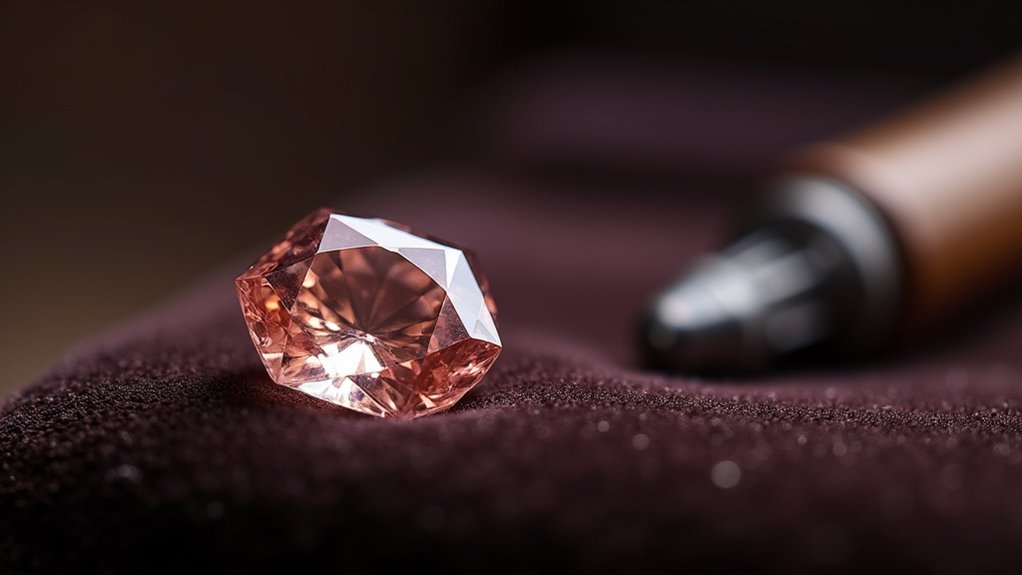
Romance and candlelight define the enchanting story of rose cut diamonds, which first emerged in 15th-century India as skilled artisans sought to capture the delicate beauty of an unfurling rosebud in stone.
By the 1520s, European jewelers embraced this innovative cutting technique, which maximized brilliance under candlelight rather than modern electric lighting.
European artisans of the 1520s perfected rose cuts to shimmer beautifully in flickering candlelight, long before electric illumination existed.
You’ll recognize rose cut diamonds by their distinctive flat base and gently domed crown featuring 3 to 24 facets. This unique structure creates a softer, more romantic glow compared to contemporary brilliant cuts.
The Georgian and Victorian eras marked the peak of their popularity, though advanced cutting technology in the early 20th century overshadowed these gems.
Today’s vintage jewelry revival has rekindled appreciation for their artistry and origins.
Essential Characteristics of Rose Cut Faceting
Every rose cut diamond showcases a distinctive flat-bottomed structure topped with a gently curved dome, creating an architectural profile that’s instantly recognizable to gem enthusiasts.
This unique flat base eliminates the traditional pavilion, allowing more surface area on top that makes your stone appear larger than brilliant cuts of equivalent carat weight.
You’ll notice rose cuts contain 3 to 24 facets arranged in a pattern specific to each stone, requiring skilled hand-cutting techniques.
These fewer facets reflect light differently than modern cuts, producing a soft, candlelight-friendly glow rather than intense sparkle.
However, this characteristic makes visible inclusions more apparent, so you’ll want to select higher clarity grades like VS2 or better.
Each rose cut diamond offers distinctive beauty through its gentle luminescence.
Rose Cut Vs Brilliant Cut Faceting Differences
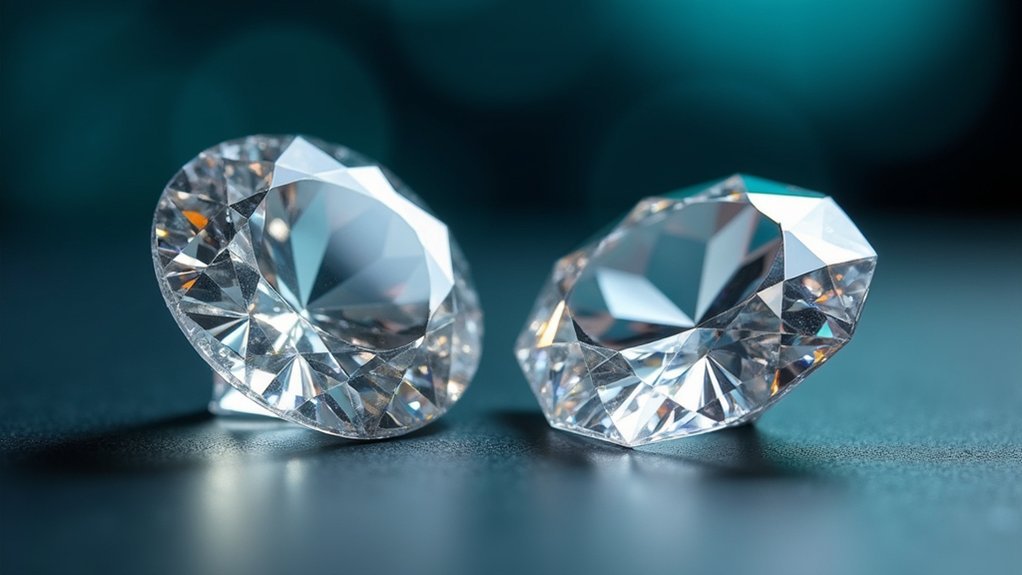
While brilliant cuts dominate today’s jewelry market with their 57 to 58 precisely engineered facets, rose cuts take a fundamentally different approach with their simpler 3 to 24 facet arrangement.
These fundamental differences create distinct diamond features that affect how you’ll experience each stone.
These cutting style differences translate into dramatically different visual experiences when wearing the diamonds.
The key distinctions you’ll notice include:
- Light reflection patterns – Rose cuts produce a soft, candlelight-like glow while brilliant cuts deliver intense sparkle through complex light reflection.
- Visual size perception – Rose cuts appear larger than brilliant cuts of identical carat weight due to their greater surface area.
- Clarity visibility – Rose cuts reveal inclusions more readily, whereas brilliant cuts use numerous facets to mask imperfections.
You’ll find rose cuts sit closer to your skin without pavilions, creating a unique flat-backed aesthetic.
Tools and Materials Needed for Rose Cut Faceting
You’ll need specialized equipment to successfully facet rose cut diamonds, starting with essential cutting tools that provide precision and control.
Proper diamond holding devices guarantee your gemstone stays secure throughout the cutting process while allowing access to all faceting angles.
Quality polishing and finishing supplies complete your toolkit, enabling you to achieve the smooth, reflective surfaces that make rose cuts so distinctive.
Essential Cutting Equipment
Before you can begin faceting rose cut diamonds, you’ll need to invest in specialized equipment that guarantees precision and safety throughout the cutting process.
Your diamond cutting wheel, coated with diamond dust, guarantees precise shaping and finishing. A quality faceting machine provides accurate angle adjustments and consistent pressure for achieving desired facets. You’ll also need a dop stick to securely hold diamonds during cutting.
Essential components for successful diamond cutting include:
- Measurement tools – Calipers for accurate dimensions and a loupe for inspecting facets and clarity
- Safety equipment – Protective goggles and gloves to prevent injury during handling
- Finishing materials – Polishing compounds and lubricants to refine surfaces and enhance brilliance
This specialized equipment forms the foundation for professional-quality rose cut diamond faceting.
Diamond Holding Devices
Among all your cutting equipment, diamond holding devices serve as the foundation that determines your faceting success or failure. Dop sticks are your primary holding tools, securing diamonds firmly while you work on your faceting machine. They prevent stone movement during cutting, ensuring you’ll achieve precise angles without damaging your gem.
You’ll need various dop stick sizes to accommodate different diamond dimensions. Proper attachment requires heating the dop wax carefully – too hot damages the stone, too cool creates weak bonds.
Your diamond holding devices work alongside your lap cutting wheel and diamond dust abrasives to create clean facets. Always inspect your setup using a microscope before beginning work.
Remember your safety tools throughout the process, as secure diamond holding devices protect both you and your valuable stones from accidents.
Polishing and Finishing Supplies
After securing your diamond with proper holding devices, polishing and finishing supplies transform your rough-cut facets into brilliant, mirror-like surfaces.
Your faceting machine’s polishing wheel, typically metal or ceramic, works alongside ultra-fine diamond polishing powders ranging from 50,000 to 100,000 grit to achieve professional-quality finishes.
Essential supplies you’ll need include:
- Diamond polishing powders – Multiple grits for progressive refinement of each facet
- Lubricants – Water or oil to reduce friction and prevent heat damage to the diamond surface
- Safety equipment – Goggles and dust masks to protect against fine particulates
Don’t underestimate the importance of proper lubrication during polishing.
It prevents overheating that can damage your diamond surface and guarantees even, consistent results across all facets.
Step-by-Step Rose Cut Faceting Process
You’ll start your rose cut faceting journey by carefully examining your rough diamond to determine its best potential shape and yield.
Next, you’ll use laser cutting technology to establish the foundation shape before shifting to the detailed work ahead.
Finally, you’ll apply specialized hand faceting techniques to create the distinctive dome structure that makes rose cuts so intriguing.
Initial Diamond Assessment Process
Before any diamond can become a stunning rose cut, three vital factors determine its suitability for this distinctive faceting style.
The initial diamond assessment process requires you to thoroughly evaluate the rough diamond’s quality before committing to this specialized cut.
You’ll need to examine these essential characteristics:
- Weight and size – Determines if there’s sufficient material for the rose cut’s signature dome structure
- Color grading – Influences how light will interact with the final faceted surface
- Clarity evaluation – Identifies inclusions that could compromise the diamond’s beauty
During this assessment, you must identify imperfections that’ll affect the final appearance.
Your attention to detail here directly impacts the symmetry and precision achievable during faceting, making this evaluation vital for rose cut success.
Laser Cutting Foundation Shape
Precision laser technology transforms your carefully assessed rough diamond into the foundation shape that defines a rose cut diamond’s distinctive character. The laser cutting process creates a flat base with a domed top, establishing the groundwork for subsequent faceting. This precision approach guarantees consistent, symmetrical outlines while efficiently removing excess material to maximize yield from your rough diamond.
| Step | Process | Purpose | Outcome |
|---|---|---|---|
| 1 | Initial laser shaping | Create foundation outline | Symmetrical base structure |
| 2 | Dome formation | Establish curved top surface | Proper proportions |
| 3 | Material removal | Maximize diamond yield | Preserved integrity |
| 4 | Shape refinement | Prepare for hand-faceting | Ready for artisans |
After laser cutting completes the foundation work, skilled artisans begin meticulously hand-faceting your diamond, adding the characteristic facets that create rose cut’s unique visual appeal.
Hand Faceting Techniques
Once laser cutting establishes your diamond’s foundation, the transformative hand-faceting process begins with skilled diamantaires carefully positioning each facet to maximize light reflection.
You’ll witness artisans meticulously create between 3 to 24 facets on your rose cut diamond, with each placement directly impacting the diamond’s quality and brilliance.
The hand faceting process follows three critical principles:
- Precise facet placement – Each cut must enhance your diamond’s natural characteristics
- Perfect symmetry – Even spacing creates visual balance and aesthetic appeal
- Artistic customization – Personalized approaches that machine cutting can’t replicate
This technique minimizes material waste while maximizing your diamond’s potential.
You’ll appreciate how hand faceting allows for an artistic result that celebrates your stone’s unique properties, creating a one-of-a-kind piece that reflects both craftsmanship and natural beauty.
Common Rose Cut Shapes and Variations
While rose cut diamonds maintain their signature flat base and triangular facets across all variations, they’re available in several distinct shapes that dramatically affect their visual impact and jewelry applications.
Rose cut diamonds come in common shapes including round, oval, pear, cushion, and hexagon, each offering a unique aesthetic suitable for different jewelry styles.
The classic round rose cut features a circular outline with a gentle dome, while oval variations provide an elongated silhouette.
Pear rose cuts combine soft curves with teardrop points, making them perfect for elegant pendants and earrings.
Marquise shapes offer symmetrical pointed ends that create a larger appearance, often favored for vintage-inspired designs.
Square and cushion rose cuts are rarer options that deliver bold, distinct looks for personalized pieces.
Clarity Considerations in Rose Cut Faceting
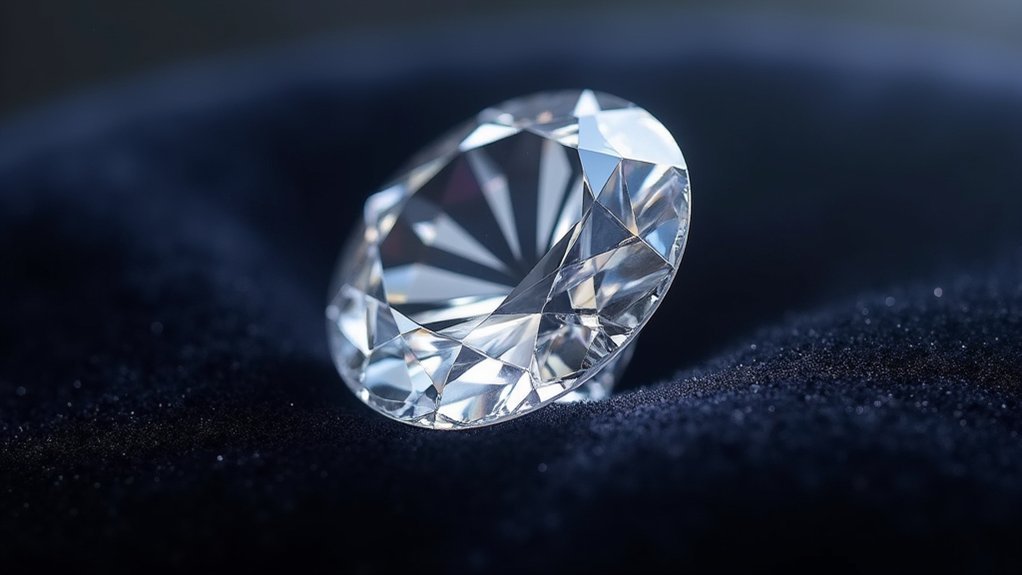
Beyond choosing the perfect shape for your rose cut diamond, understanding how clarity affects these unique stones becomes vital to making an informed purchase.
Rose cut diamonds reveal inclusions more readily than brilliant cuts because they’ve fewer facets to mask imperfections. This transparency makes clarity grades especially important for your selection.
When evaluating rose cut diamonds, consider these essential clarity factors:
- Target VS2 or higher clarity grades to guarantee inclusions don’t distract from the stone’s beauty
- Look for symmetrical facet arrangements that enhance visual balance and clarity perception
- Consider that heavily included stones can actually add unique charm to rose cuts rather than detract
The flat bottom and domed top design emphasizes internal characteristics, making clarity considerations vital for ideal appearance.
Troubleshooting Rose Cut Faceting Challenges
Although rose cut diamonds offer timeless beauty, the faceting process presents unique technical challenges that require careful attention and specialized techniques.
You’ll need to assess your rough diamond quality thoroughly before cutting, as imperfections can compromise your final rose cut diamond jewelry. Pay close attention to facet symmetry and spacing—uneven facets create poor balance and affect brilliance and sparkle.
Start with laser-cutting technology for initial shaping, then switch to hand-faceting for precision work. Monitor your dome’s angle and depth carefully; incorrect height ruins brilliance or creates flat appearances. The diamond holds its value when you achieve proper proportions through the faceting process.
Inspect your work regularly throughout each stage to identify issues early, preventing complications that could ruin your perfect piece.
Finishing and Polishing Rose Cut Diamonds
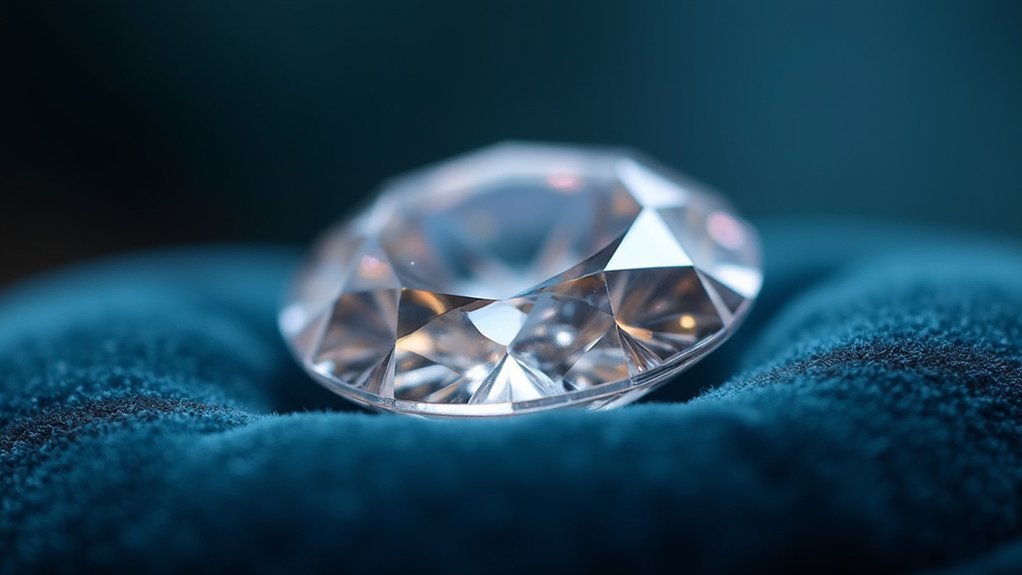
Once you’ve completed the faceting process, the finishing and polishing stage determines whether your rose cut diamond achieves its signature soft glow and gentle brilliance.
The final polishing stage is where your rose cut diamond transforms into a masterpiece of soft, enchanting brilliance.
You’ll need to meticulously hand-facet each surface to guarantee perfect symmetry and precision, which enhances the stone’s unique aesthetic appeal.
Here are three essential polishing techniques for rose cut diamonds:
- Use diamond dust powder on a soft cloth or wheel to create a smooth, reflective surface
- Polish the flat base carefully to prevent scratches and maintain structural integrity for jewelry settings
- Inspect regularly during polishing to maintain technique quality and prevent dullness
The beauty of rose cut diamonds lies in their fewer facets working together harmoniously.
Through careful finishing, you’ll create effective light reflection that distinguishes these stones from modern brilliant cuts.
Frequently Asked Questions
Are Rose Cut Diamonds Worth Anything?
You’ll find rose cut diamonds are definitely worth something, ranging from $1,200 to $50,000 per carat for natural stones. Their historical significance and unique charm make them valuable to collectors and vintage jewelry enthusiasts.
How Many Carats Is a 3mm Rose Cut Diamond?
You’ll find a 3mm rose cut diamond typically weighs 0.1 to 0.15 carats, averaging around 0.12 carats. The flat bottom design makes it appear larger than its actual carat weight suggests.
How Many Facets Are in a Rose Cut Diamond?
You’ll find rose cut diamonds typically have 3 to 24 facets, creating their signature soft glow. The exact number depends on the stone’s shape and size, with skilled cutters customizing arrangements to maximize each diamond’s natural beauty.
What Is the Difference Between Single Rose Cut and Double Rose Cut?
You’ll find single rose cuts have flat bottoms with facets only on top, while double rose cuts feature additional facets underneath, creating more depth, brilliance, and visual complexity than their simpler counterparts.
In Summary
You’ve now mastered the fundamentals of rose cut diamond faceting, from understanding its rich history to executing the precise step-by-step process. You can confidently select appropriate tools, navigate common challenges, and achieve that distinctive flat-backed, domed appearance that makes rose cuts so enchanting. Remember to prioritize clarity considerations and take your time with finishing touches. With practice, you’ll develop the expertise needed to create stunning rose cut diamonds that showcase this timeless faceting style’s unique beauty and charm.

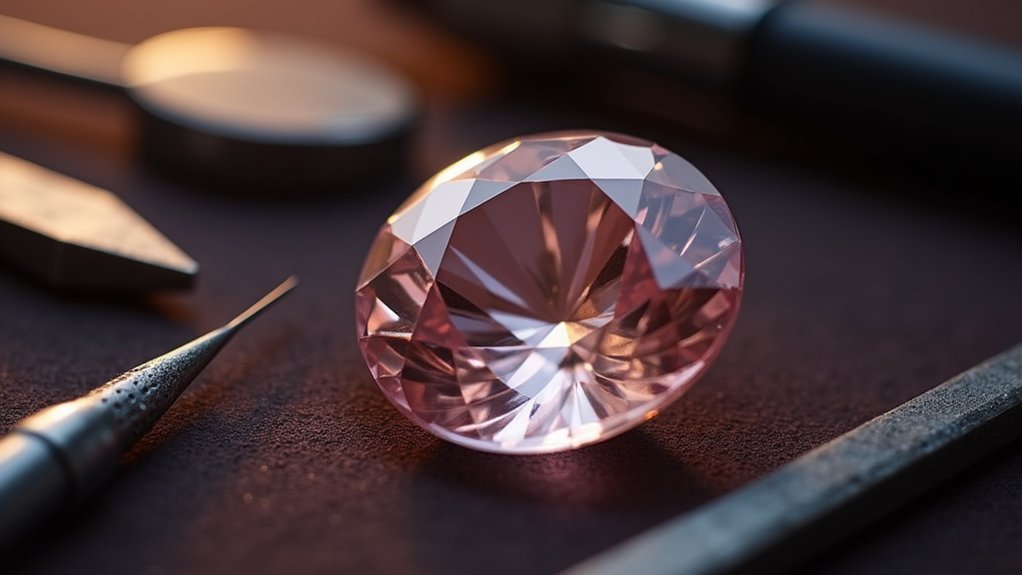

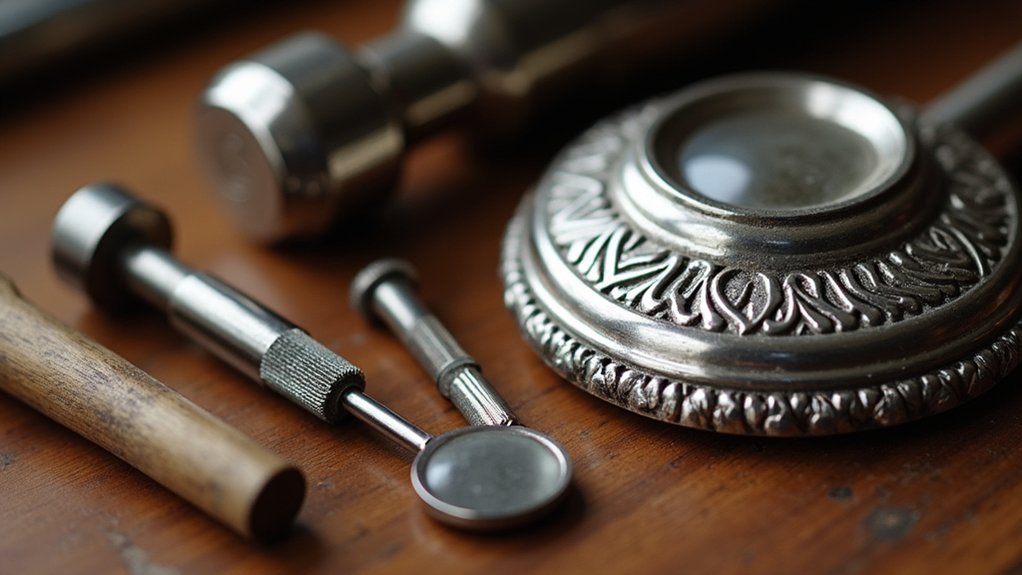
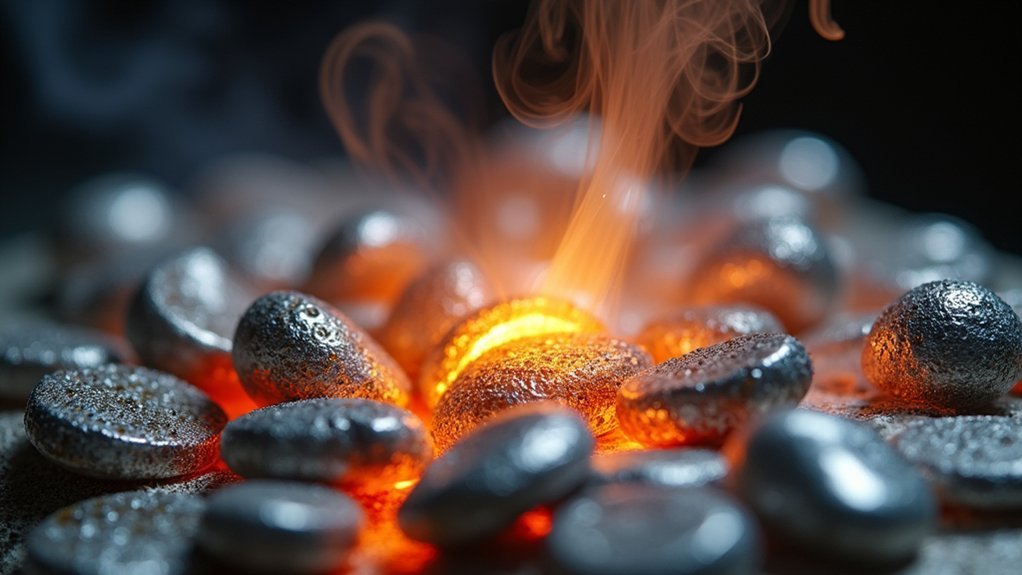
Leave a Reply